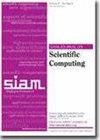非线性动力系统的张量参数模型阶次削减
IF 2.6
2区 数学
Q1 MATHEMATICS, APPLIED
引用次数: 0
摘要
SIAM 科学计算期刊》,第 46 卷第 3 期,第 A1850-A1878 页,2024 年 6 月。 摘要对于依赖于参数的非线性动力系统,本文介绍了一种新的张量减阶模型(TROM)。简化模型以投影为基础,对于不涉及参数的系统,它类似于适当正交分解(POD)与离散经验插值法(DEIM)的结合。对于参数系统,TROM 采用低秩张量近似来代替截断 SVD,而截断 SVD 是 POD 与 DEIM 的一项关键降维技术。为此,我们考虑了三种流行的低阶张量压缩格式:典型多面体、塔克和张量列车。通过使用多线性代数工具,可以将系统的参数依赖性信息纳入缩减模型中,并产生 POD-DEIM 类型的 ROM:(i) 针对特定参数(本地化),并预测训练集外(未见)参数值的系统动态、(iii) 在线计算成本只取决于张量压缩等级,而不取决于全阶模型大小;以及 (iv) 与传统的 POD-DEIM ROM 相比,可实现更低的空间缩减维度。本文解释了该方法,分析了其预测能力,并评估了其在两个特定参数依赖非线性动力系统中的性能。本文章由计算机程序翻译,如有差异,请以英文原文为准。
Tensorial Parametric Model Order Reduction of Nonlinear Dynamical Systems
SIAM Journal on Scientific Computing, Volume 46, Issue 3, Page A1850-A1878, June 2024.
Abstract. For a nonlinear dynamical system that depends on parameters, this paper introduces a novel tensorial reduced-order model (TROM). The reduced model is projection-based, and for systems with no parameters involved, it resembles proper orthogonal decomposition (POD) combined with the discrete empirical interpolation method (DEIM). For parametric systems, TROM employs low-rank tensor approximations in place of truncated SVD, a key dimension-reduction technique in POD with DEIM. Three popular low-rank tensor compression formats are considered for this purpose: canonical polyadic, Tucker, and tensor train. The use of multilinear algebra tools allows the incorporation of information about the parameter dependence of the system into the reduced model and leads to a POD-DEIM type ROM that (i) is parameter-specific (localized) and predicts the system dynamics for out-of-training set (unseen) parameter values, (ii) mitigates the adverse effects of high parameter space dimension, (iii) has online computational costs that depend only on tensor compression ranks but not on the full-order model size, and (iv) achieves lower reduced space dimensions compared to the conventional POD-DEIM ROM. This paper explains the method, analyzes its prediction power, and assesses its performance for two specific parameter-dependent nonlinear dynamical systems.
Abstract. For a nonlinear dynamical system that depends on parameters, this paper introduces a novel tensorial reduced-order model (TROM). The reduced model is projection-based, and for systems with no parameters involved, it resembles proper orthogonal decomposition (POD) combined with the discrete empirical interpolation method (DEIM). For parametric systems, TROM employs low-rank tensor approximations in place of truncated SVD, a key dimension-reduction technique in POD with DEIM. Three popular low-rank tensor compression formats are considered for this purpose: canonical polyadic, Tucker, and tensor train. The use of multilinear algebra tools allows the incorporation of information about the parameter dependence of the system into the reduced model and leads to a POD-DEIM type ROM that (i) is parameter-specific (localized) and predicts the system dynamics for out-of-training set (unseen) parameter values, (ii) mitigates the adverse effects of high parameter space dimension, (iii) has online computational costs that depend only on tensor compression ranks but not on the full-order model size, and (iv) achieves lower reduced space dimensions compared to the conventional POD-DEIM ROM. This paper explains the method, analyzes its prediction power, and assesses its performance for two specific parameter-dependent nonlinear dynamical systems.
求助全文
通过发布文献求助,成功后即可免费获取论文全文。
去求助
来源期刊
CiteScore
5.50
自引率
3.20%
发文量
209
审稿时长
1 months
期刊介绍:
The purpose of SIAM Journal on Scientific Computing (SISC) is to advance computational methods for solving scientific and engineering problems.
SISC papers are classified into three categories:
1. Methods and Algorithms for Scientific Computing: Papers in this category may include theoretical analysis, provided that the relevance to applications in science and engineering is demonstrated. They should contain meaningful computational results and theoretical results or strong heuristics supporting the performance of new algorithms.
2. Computational Methods in Science and Engineering: Papers in this section will typically describe novel methodologies for solving a specific problem in computational science or engineering. They should contain enough information about the application to orient other computational scientists but should omit details of interest mainly to the applications specialist.
3. Software and High-Performance Computing: Papers in this category should concern the novel design and development of computational methods and high-quality software, parallel algorithms, high-performance computing issues, new architectures, data analysis, or visualization. The primary focus should be on computational methods that have potentially large impact for an important class of scientific or engineering problems.

 求助内容:
求助内容: 应助结果提醒方式:
应助结果提醒方式:


